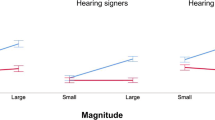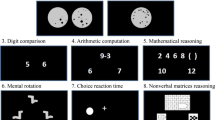Abstract
Research shows that deaf children have inferior achievement in simple arithmetic compared to their hearing agemates. The reported study investigates whether the reasons for deaf children's poor achievement can be sought in their strategy development. As this is a central issue, the strategies used by deaf children when solving symbolic addition and subtraction problems are identified, classified and compared to findings from earlier research, involving both deaf and hearing children. The effect of Sign Language in strategy invention and use is the main concern in this study. One result from the present study is that structural aspects of Sign Language counting may influence deaf children's thinking in a way that does not lead to a developed conceptual knowledge base, but instead to refined procedural competence. This is a development in simple arithmetic that is compatible with that of less able hearing children. The counting procedures used by the deaf children involve both oral counting and Sign Language counting. Due to the small sample size, and the shortcomings of the research design, the results are more suggestive than conclusive. Thus, further studies are needed in this area.
Similar content being viewed by others
References
Allen, T.E.: 1986, ‘Patterns of academic achievement among hearing impaired students: 1974 and 1983’, in A.N. Schildroth and M.A. Karchmer (eds.), Deaf Children in America, College Hills Press, San Diego, Ca. pp. 161–206.
Brissiaud, R.: 1992, ‘A tool for number construction: Finger symbol sets’, in J. Bideaud, C. Meljac and J-P. Fischer (eds.), Pathways to Number. Children Developing Numerical Abilities, Lawrence Erlbaum Associates, Hillsdale, NJ, pp. 41–67.
Bråten, I.: 1996, Cognitive Strategies in Mathematics. Report no. 10, 1996, University of Oslo, Oslo.
Carpenter, T.P., Hiebert, J. and Moser, J.M.: 1981, ‘Problem structure and first-grade children's initial solution processes for simple addition and subtraction problems’, Journal for Research in Mathematics Education 12, 27–39.
Carpenter, T.P. and Moser, J.M.: 1982, ‘The development of addition and subtraction problem solving skills’, in T.P. Carpenter, J.M. Moser and T. Romberg (eds.), Addition and Subtraction: A Cognitive Perspective, Erlbaum, Hillsdale, NJ, pp. 2–24.
Chien, S.J.: 1993, Cognitive Addition: Strategy Choice in Young Children with Normal Hearing and Children with Hearing Impairment, UMI Dissertation Services.
Frostad, P.: 1996, ‘Mathematical achievement of hearing-impaired students in Norway’, European Journal of Special Needs Education 11(1), 66–80.
Fuson, K.C.: 1992, ‘Research on whole number addition and subtraction’, in D.A. Grouws (ed.), Handbook of Research on Mathematics Teaching and Learning. Macmillan Publishing Company, New York, pp. 243–276.
Geary, D.C. and Brown, S.C.: 1991, ‘Cognitive addition: Strategy choice and speed-of-processing differences in gifted, normal and mathematically disabled children’, Developmental Psychology 27(3), 398–406.
Geary, D.C., Brown, S.C. and Samaranayake, V.A.: 1991, ‘Cognitive addition: A short longitudinal study of strategy choice and speed-of-processing differences in normal and mathematically disabled children’, Developmental Psychology 27(5), 787–797.
von Glasersfeld, E.: 1993, ‘Reflection on number and counting’, in S.T. Boysen and E.J. Capaldi (eds.), The Development of Numerical Competence. Animal and Human Models. Hillsdale, Lawrence Erlbaum, New Jersey, pp. 225–244.
Gray, E.M.: 1991, ‘An analysis of diverging approaches to simple arithmetic: preference and its concequences’, Educational Studies in Mathematics 22, 551–574.
Gray, E.M.: 1994, ‘Procepts and procedures: Traversing the mathematical landscape’, Paper Presented at the University of Gothenbourg, Sweden, November 1994.
Gray, E.M. and Tall, D.O.: 1994, ‘Duality, ambiguity, and flexibility: A ‘proceptual’ view of simple arithmetic’, Journal for Research in Mathematics Education 25(2), 116–140.
Groen, G.J. and Parkman, J.M.: 1972, ‘A chronometric analysis of simple addition’, Psychological Review 79, 329–343.
Heiling, K.: 1993, Döva barns utveckling i ett tidsperspektiv, (Deaf children's development over time.) Almqvist & Wiksell International, Stockholm.
Hiebert, J. and Lefevre, P.: 1986, ‘Conceptual knowledge in mathematics: An introductory analysis’, in J. Hiebert (ed.), Conceptual and Procedural Knowledge: The Case of Mathematics, Lawrence Erlbaum Associates, Hillsdale, NJ, pp. 1–29.
Hitch, G.J., Arnold, P. and Phillips, L.J.: 1983, ‘Counting processes in deaf children's arithmetic’, British Journal of Psychology 74, 429–437.
Hoc, J.-M.: 1987, Psychologie cognitive de la planification, Presses Universitaires de Grenoble, Grenoble.
Klahr, D. and Wallace, J.G.: 1976, Cognitive Development: An Information Processing View, Erlbaum, Hillsdale, NJ.
Mulhern, G. and Budge, A.: 1993, ‘A chronometric study of mental addition in profoundly deaf children’, Applied Cognitive Psychology 7, 53–62.
Neuman, D.: 1987, The Origin of Arithmetic Skills. A Phenomenographic Approach. Doctoral Dissertation, Acta Universitatis Gothoburgensis.
Piaget, J.: 1952, The Child's Conception of Number, Routledge and Keagan Paul, London.
Secada, W.G.: 1981, Solution Procedures Used by Manually Trained Deaf Children in Subtraction, Unpublished manuscript.
Secada, W.G.: 1984, Counting in Sign: The Number String, Accuracy and Use, Dissertation Abstracts International, 45, 3571A.
Siegler, R.S.: 1987, ‘The perils of averaging data over strategies. An example from children's addition’, Journal of Experimental Psychology: General 116, 250–264.
Siegler, R.S.: 1989, ‘The hazards of mental chronometry: An example from children's subtraction’, Journal of Educational Psychology 81, 497–506.
Siegler, R.S.: 1991, Children's Thinking (2nd edition), Prentice Hall, NJ.
Siegler, R.S. and Shrager, J.: 1984, ‘Strategy choices in addition and subtraction: How do children know what to do?’, in C. Sophian (ed.), Origins of Cognitive Skills. Lawrence Erlbaum, Hillsdale, NJ, 229–293.
Steffe, L.P. and Cobb, P.: 1988, Construction of Arithmetical Meaning and Strategies, Springer-Verlag, New York.
Steffe, L.P., von Glasersfeld, E., Richards, J. and Cobb, P.: 1983, Children's Counting Types: Philosophy Theory and Application, Praeger Scientific, New York.
Author information
Authors and Affiliations
Rights and permissions
About this article
Cite this article
Frostad, P. Deaf children's use of cognitive strategies in simple arithmetic problems. Educational Studies in Mathematics 40, 129–153 (1999). https://doi.org/10.1023/A:1003609532442
Issue Date:
DOI: https://doi.org/10.1023/A:1003609532442




